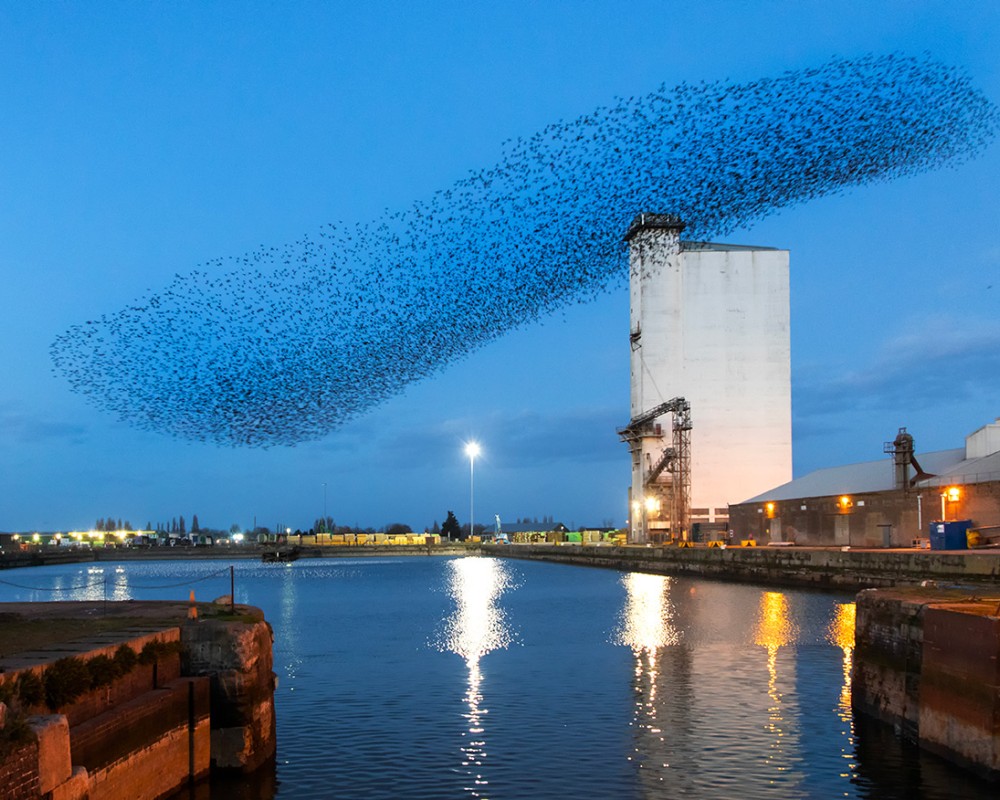
King’s Lynn’s spectacular starlings
Earlier this year, starlings were tracked for the first time in King’s Lynn. Will you be lucky enough to witness a murmuration this winter?
Liquid streaks of black twitch and twirl against the sunset-hued sky, the last vestiges of the day joined in celebration by the starlings, deep in murmuration. One of the most amazing sights in nature to witness, a murmuration is a large flock of starlings flying in coordinated patterns, creating mesmerising shapes and movements in the sky. A stunning display of collective intelligence and beauty, the murmuration is a mystery that scientists are still trying to unravel.
Starlings are relatively small, social birds that can be found all over the world. They are adaptable and opportunistic creatures, feeding on a combination of insects, seeds and fruits. Known for their vocal abilities, which are astounding in both variety and complexity, starlings can produce a wealth of different sounds. These range from whistles and clicks to warbles and rattles. They are capable of learning new sounds throughout their lives and can recognise individual birds by their calls, often imitating other species with remarkable accuracy. Starlings can also mimic human speech and are known to incorporate sounds from their environment into their own repertoire.
In the winter, when food is scarce and predators are abundant, starlings form large groups. They choose to roost together at night, as a collective will always offer more protection than being alone. The resourceful birds tend to assemble in urban areas, where they can find warmth and shelter. During the daytime they disperse to forage, but before sunset they gather once again in their group to perform their aerial ballet.
As darkness encroaches the starlings seek to roost, a final act perhaps best described by the Wildlife Trust: “As the numbers reach their peak and the last of the light fades, the birds suddenly decide the time is right, as if by a secret signal. They funnel down into the reeds in one last whoosh of wings, and the show’s over. The birds settle down to sleep and it’s time to head home.”

It is not known with any certainty why starlings murmurate, but there are several possible explanations. One is that this combined movement is a way of communicating information about food sources, roosting sites and potential threats. Another theory is that it is a way of creating a confusing sight for predators, such as hawks and falcons, deterring them by creating an illusion of a larger entity. It’s also thought that it could be a way of attracting mates, by showing off their flying skills and coordination.
Whatever the reasons behind the formation, murmurations are a scientifically fascinating example of self-organisation and emergent behaviour amongst starlings. Each individual bird follows a simple set of rules: stay close to your neighbours, but not too close; match their speed and direction; and avoid collisions. Out of these simple rules emerges a complex and dynamic pattern that changes every second. Scientists have used mathematical models and computer simulations to study how starlings achieve this feat, but there is still much to learn.
Witnessing a starling murmuration is an awe-inspiring event which usually occurs during the winter months, from October to March, and happens just before dusk. The best places to see them are near open fields, wetlands or water. The dockland area of King’s Lynn has been tracked as a new location, with Norfolk’s wide-open skies providing an excellent backdrop to really appreciate the art of the starlings. Their elegant swirls and ever-changing forms sit in perfect juxtaposition with the rugged industrious fisher fleet and the indomitable harbour buildings.



Starlings are not just fascinating birds to observe and study. These remarkable creatures are also important to the ecosystems they inhabit, pollinating plants, dispersing seeds, controlling pests, and enriching soils. Sadly, their numbers are declining in the UK and Northern Europe. According to the RSPB, the starling population has fallen by more than 80% in recent years, and they are now on the at-risk list of the UK’s most critically endangered birds. The decline is believed to be due to the loss of permanent pasture, increased use of farm chemicals and a shortage of food and nesting sites in many parts of the UK.
Head out into the evening with binoculars in hand to witness the flight of these astounding birds for yourself. Starlings are relatively easy to spot, they are characterised by a short tail, pointed head and triangular wings. When viewed from a distance starlings look black but on closer inspection, they have a green and purple sheen. There are many birdwatching resources available online which help you to find where others have spotted starlings. Starlingsintheuk.co.uk have a roost map which enables people to report murmurations and the collective data can help to build a picture of the UK’s starling population.
Step out into the cool evening air and head towards the docks, specifically Cross Brink Road. Should they return, you may catch a glimpse of the starlings in their mysterious dance as the light sinks from the boundless Norfolk sky.

